A New Approach to Quantify Shallow Water Hydrologic Exchanges in a Large Regulated River Reach
Abstract
:1. Introduction
1.1. Hydrologic Exchange and River Regulations
1.2. Approaches to Measuring HEF Rates
1.3. Study Objectives
2. Method
2.1. Study Reach
2.2. Data Revisiting
2.3. Using Temperature Records to Infer Vertical HEF Rates
2.4. Monitoring near Riverbed Temperature along the River
3. Results
4. Discussion and Conclusions
Acknowledgments
Author Contributions
Conflicts of Interest
References
- Harvey, J.; Gooseff, M. River corridor science: Hydrologic exchange and ecological consequences from bedforms to basins. Water Resour. Res. 2015, 51, 6893–6922. [Google Scholar] [CrossRef]
- Findlay, S.; Strayer, D.; Goumbala, C.; Gould, K. Metabolism of streamwater dissolved organic carbon in the shallow hyporheic zone. Limnol. Oceanogr. 1993, 38, 1493–1499. [Google Scholar] [CrossRef]
- Sobczak, W.V.; Findlay, S. Variation in bioavailability of dissolved organic carbon among stream hyporheic flowpaths. Ecology 2002, 83, 3194–3209. [Google Scholar] [CrossRef]
- Anderson, M.P. Heat as a ground water tracer. Ground Water 2005, 43, 951–968. [Google Scholar] [CrossRef] [PubMed]
- Valett, H.M.; Morrice, J.A.; Dahm, C.N.; Campana, M.E. Parent lithology, surface-groundwater exchange, and nitrate retention in headwater streams. Limnol. Oceanogr. 1996, 41, 333–345. [Google Scholar] [CrossRef]
- Zarnetske, J.P.; Haggerty, R.; Wondzell, S.M.; Baker, M.A. Dynamics of nitrate production and removal as a function of residence time in the hyporheic zone. J. Geophys. Res. Biogeosci. 2011, 116, 1–12. [Google Scholar] [CrossRef]
- Mollema, P.N.; Antonellini, M. Water and (bio)chemical cycling in gravel pit lakes: A review and outlook. Earth-Sci. Rev. 2016, 159, 247–270. [Google Scholar] [CrossRef]
- Tonina, D.; Buffington, J.M. Hyporheic exchange in gravel bed rivers with pool-riffle morphology: Laboratory experiments and three-dimensional modeling. Water Resour. Res. 2007, 43. [Google Scholar] [CrossRef]
- Morrice, J.A.; Valett, H.M.; Dahm, C.N.; Campana, M.E. Alluvial characteristics, groundwater-surface water exchange and hydrological retention in headwater streams. Hydrol. Process. 1997, 11, 253–267. [Google Scholar] [CrossRef]
- Boulton, A.; Findlay, S.; Marmonier, P. The functional significance of the hyporheic zone in streams and rivers. Annu. Rev. Ecol. Syst. 1998, 29, 59–81. [Google Scholar] [CrossRef]
- Winter, T.C. Relation of streams, lakes, and wetlands to groundwater flow systems. Hydrogeol. J. 1999, 7, 28–45. [Google Scholar] [CrossRef]
- Brunke, M.; Gonser, T.; Brunke, M.; Gonser, T.; Gonser, T. The ecological significance of exchange processes between rivers and groundwater. Freshw. Biol. 1997, 37, 1–33. [Google Scholar] [CrossRef]
- Zhou, T.; Endreny, T.A. Reshaping of the hyporheic zone beneath river restoration structures: Flume and hydrodynamic experiments. Water Resour. Res. 2013, 49, 5009–5020. [Google Scholar] [CrossRef]
- Poff, N.L.; Allan, J.D.; Bain, M.B.; Karr, J.R.; Prestegaard, K.L.; Richter, B.D.; Sparks, R.E.; Stromberg, J.C. The Natural Flow Regime: A paradigm for river conservation and restoration N. Bioscience 1997, 47, 769–784. [Google Scholar] [CrossRef]
- Arntzen, E.V.; Geist, D.R.; Dresel, P.E. Effects of fluctuating river flow on groundwater/surface water mixing in the hyporheic zone of a regulated, large cobble bed river. River Res. Appl. 2006, 22, 937–946. [Google Scholar] [CrossRef]
- Vörösmarty, C.J.; Sahagian, D.L. Anthropogenic disturbance of the terrestrial water cycle. Bioscience 2000, 50, 753–765. [Google Scholar] [CrossRef]
- Hanasaki, N.; Kanae, S.; Oki, T. A reservoir operation scheme for global river routing models. J. Hydrol. 2006, 327, 22–41. [Google Scholar] [CrossRef]
- Zhou, T.; Nijssen, B.; Gao, H.; Lettenmaier, D.P. The contribution of reservoirs to global land surface water storage variations. J. Hydrometeorol. 2016, 17, 309–325. [Google Scholar] [CrossRef]
- Ward, J.V.; Stanford, J.A. Ecological connectivity in alluvial river ecosystems and its disruption by flow regulation. Regul. Rivers Res. Manag. 1995, 11, 105–119. [Google Scholar] [CrossRef]
- Cardenas, M.B.; Markowski, M.S. Geoelectrical imaging of hyporheic exchange and mixing of river water and groundwater in a large regulated river. Environ. Sci. Technol. 2011, 45, 1407–1411. [Google Scholar] [CrossRef] [PubMed]
- Gerecht, K.E.; Cardenas, M.B.; Guswa, A.J.; Sawyer, A.H.; Nowinski, J.D.; Swanson, T.E. Dynamics of hyporheic flow and heat transport across a bed-to-bank continuum in a large regulated river. Water Resour. Res. 2011, 47, 1–12. [Google Scholar] [CrossRef]
- Sawyer, A.; Bayani Cardenas, M.; Bomar, A.; Mackey, M. Impact of dam operations on hyporheic exchange in the riparian zone of a regulated river. Hydrol. Process. 2009, 23, 2129–2137. [Google Scholar] [CrossRef]
- Cranswick, R.H.; Cook, P.G. Scales and magnitude of hyporheic, river-aquifer and bank storage exchange fluxes. Hydrol. Process. 2015, 29, 3084–3097. [Google Scholar] [CrossRef]
- Kalbus, E.; Reinstorf, F.; Schirmer, M. Measuring methods for groundwater, surface water and their interactions: A review. Hydrol. Earth Syst. Sci. Discuss. 2006, 3, 1809–1850. [Google Scholar] [CrossRef]
- Murdoch, L.C.; Kelly, S.E. Factors affecting the performance of conventional seepage meters. Water Resour. Res. 2003, 39. [Google Scholar] [CrossRef]
- Paulsen, R.J.; Smith, C.F.; O’Rourke, D.; Wong, T.F. Development and evaluation of an ultrasonic ground water seepage meter. Ground Water 1997, 39, 904–911. [Google Scholar] [CrossRef]
- Lee, D.R. A device for measuring seepage flux in lakes and estuaries. Limnol. Oceanogr. 1977, 22, 140–147. [Google Scholar] [CrossRef]
- Rosenberry, D.O. A seepage meter designed for use in flowing water. J. Hydrol. 2008, 359, 118–130. [Google Scholar] [CrossRef]
- Freeze, A.; Cherry, J. Groundwater; Prentice-Hall: Englewood Cliffs, NJ, USA, 1979. [Google Scholar]
- Suzuki, S. Percolation measurements based on heat flow through soil with special reference to paddy fields. J. Geophys. Res. 1960, 65, 2883–2885. [Google Scholar] [CrossRef]
- Stallman, R.W. Steady one-dimensional fluid flow in a semi-infinite porous medium with sinusoidal surface temperature. J. Geophys. Res. 1965, 70, 2821–2827. [Google Scholar] [CrossRef]
- Turcotte, D.; Schubert, G. Geodynamics; Cambridge University Press: Cambridge, UK, 2002. [Google Scholar]
- Healy, R.W.; Ronan, A.D. Documentation of Computer Program VS2DH for Simulation of Energy Transport in Variably Saturated Porous Media—Modification of the U.S. Geological Survey’s Computer Program VS2DT; U.S. Department of the Interior, U.S. Geological Survey: Reston, VA, USA, 1996.
- Silliman, S.E.; Booth, D.F. Analysis of time-series measurements of sediment temperature for identification of gaining vs. losing portions of Juday Creek, Indiana. J. Hydrol. 1993, 146, 131–148. [Google Scholar] [CrossRef]
- Constantz, J.; Stewart, A.E.; Niswonger, R.; Sarma, L. Analysis of temperature profiles for investigating stream losses beneath ephemeral channels. Water Resour. Res. 2002, 38, 1–13. [Google Scholar] [CrossRef]
- Anibas, C.; Fleckenstein, J.H.; Volze, N.; Buis, K.; Verhoeven, R.; Meire, P.; Batelaan, O. Transient or steady-state? Using vertical temperature profiles to quantify groundwater-surface water exchange. Hydrol. Process. 2009, 23, 2165–2177. [Google Scholar] [CrossRef]
- Hatch, C.E.; Fisher, A.T.; Revenaugh, J.S.; Constantz, J.; Ruehl, C. Quantifying surface water-groundwater interactions using time series analysis of streambed thermal records: Method development. Water Resour. Res. 2006, 42. [Google Scholar] [CrossRef]
- Keery, J.; Binley, A.; Crook, N.; Smith, J.W.N. Temporal and spatial variability of groundwater–surface water fluxes: Development and application of an analytical method using temperature time series. J. Hydrol. 2007, 336, 1–16. [Google Scholar] [CrossRef]
- Vandersteen, G.; Schneidewind, U.; Anibas, C.; Schmidt, C.; Seuntjens, P.; Batelaan, O. Determining groundwater-surface water exchange from temperature-time series: Combining a local polynomial method with amaximum likelihood estimator. Water Resour. Res. 2015, 51, 922–939. [Google Scholar] [CrossRef]
- Schneidewind, U.; Anibas, C.; Vandersteen, G.; Schmidt, C.; Joris, I.; Seuntjens, P.; Batelaan, O. Delineating Groundwater-Surface Water Exchange Flux Using Temperature- Time Series Analysis Methods. In Proceedings of the 2nd European symposium on Water Technology and Management Symposium, Leuven, Belgium, 20–21 November 2013. [Google Scholar]
- Swanson, T.E.; Cardenas, M.B. Ex-Stream: A MATLAB program for calculating fluid flux through sediment–water interfaces based on steady and transient temperature profiles. Comput. Geosci. 2011, 37, 1664–1669. [Google Scholar] [CrossRef]
- Gordon, R.P.; Lautz, L.K.; Briggs, M.A.; McKenzie, J.M. Automated calculation of vertical pore-water flux from field temperature time series using the VFLUX method and computer program. J. Hydrol. 2012, 420–421, 142–158. [Google Scholar] [CrossRef]
- Fritz, B.G.; Arntzen, E.V. Effect of rapidly changing river stage on uranium flux through the hyporheic zone. Ground Water 2007, 45, 753–760. [Google Scholar] [CrossRef] [PubMed]
- Boano, F.; Harvey, J.W.; Marion, A.; Packman, A.I.; Revelli, R.; Ridolfi, L.; Wörman, A. Hyporheic flow and transport processes: Mechanisms, models, and bioghemical implications. Rev. Geophys. 2014, 1–77. [Google Scholar] [CrossRef]
- Krause, S.; Boano, F.; Cuthbert, M.O.; Fleckenstein, J.H.; Lewandowski, J. Understanding process dynamics at aquifer-surface water interfaces: An introduction to the special section on new modeling approaches and novel experimental technologies. Water Resour. Res. 2014, 50, 1847–1855. [Google Scholar] [CrossRef]
- Johnson, T.; Versteeg, R.; Thomle, J.; Hammond, G.; Chen, X.; Zachara, J. Four-dimensional electrical conductivity monitoring of stage-driven river water intrusion: Accounting for water table effects using a transient mesh boundary and conditional inversion constraints. Water Resour. Res. 2015, 51, 6177–6196. [Google Scholar] [CrossRef]
- Boano, F.; Revelli, R.; Ridolfi, L. Reduction of the hyporheic zone volume due to the stream-aquifer interaction. Geophys. Res. Lett. 2008, 35, 1–5. [Google Scholar] [CrossRef]
- Hartman, M.J. Groundwater Quality Assessment Plan for the 1324-N/NA Site; Pacific Northwest National Lab.: Richland, WA, USA, 1998; Volume 30.
- Hartman, M.J.; McDonald, J.P.; Dresel, P.E.; Newcomer, D.R.; Lindberg, J.W.; Thornton, E.C. Fiscal Year 2003 Integrated Monitoring Plan for the Hanford Groundwater Monitoring Project; United States Department of Energy: Washington, DC, USA, 2002.
- Sanford, W.E.; Selnick, D.L. Estimation of Evapotranspiration Across the Conterminous United States Using a Regression With Climate and Land-Cover Data1. JAWRA J. Am. Water Resour. Assoc. 2013, 49, 217–230. [Google Scholar] [CrossRef]
- Fayer, M.J.; Keller, J.M. Recharge Data Package for Hanford Single-Shell Tank Waste Management Areas; Pacific Northwest National Laboratory: Richland, WA, USA, 2007.
- Anibas, C.; Schneidewind, U.; Vandersteen, G.; Joris, I.; Seuntjens, P.; Batelaan, O. From streambed temperature measurements to spatial-temporal flux quantification: Using the LPML method to study groundwater-surface water interaction. Hydrol. Process. 2015, 216. [Google Scholar] [CrossRef]
- Young, P.C.; Pedregal, D.; Tych, W. Dynamic harmonic regression. J. Forecast. 1999, 18, 369–394. [Google Scholar] [CrossRef]
- Young, P.C.; Tych, W.; Taylor, C.J. The CAPTAIN Toolbox for Matlab; IFAC: New York, NY, USA, 2009; Volume 15. [Google Scholar]
- Ma, R.; Zheng, C.; Zachara, J.M.; Tonkin, M. Utility of bromide and heat tracers for aquifer characterization affected by highly transient flow conditions. Water Resour. Res. 2012, 48, 1–18. [Google Scholar] [CrossRef]
- Crispell, J.K.; Endreny, T.A. Hyporheic exchange flow around constructed in-channel structures and implications for restoration design. Hydrol. Process. 2009, 1168, 1158–1168. [Google Scholar] [CrossRef]
- Byrne, P.; Binley, A.; Heathwaite, A.L.; Ullah, S.; Heppell, C.M.; Lansdown, K.; Zhang, H.; Trimmer, M.; Keenan, P. Control of river stage on the reactive chemistry of the hyporheic zone. Hydrol. Process. 2014, 28, 4766–4779. [Google Scholar] [CrossRef]
- Sun, N.; Hong, B.; Hall, M. Assessment of the SWMM model uncertainties within the generalized likelihood uncertainty estimation (GLUE) framework for a high-resolution urban sewershed. Hydrol. Process. 2014, 28, 3018–3034. [Google Scholar] [CrossRef]
- Cardenas, M.B. Thermal skin effect of pipes in streambeds and its implications on groundwater flux estimation using diurnal temperature signals. Water Resour. Res. 2010, 46, 1–12. [Google Scholar] [CrossRef]
- Lautz, L.K. Impacts of nonideal field conditions on vertical water velocity estimates from streambed temperature time series. Water Resour. Res. 2010, 46, 1–14. [Google Scholar] [CrossRef]
- Hjulstrom, F. Transportation of Detritus by Moving Water: Part 1. Transportation. American Advancing the World of Petroleum. Special Volumes. 1939. Available online: http://archives.datapages.com/data/specpubs/sedimen1/data/a142/a142/0001/0000/0005.htm (accessed on 14 September 2017).
- Krumbein, W.; Monk, G. Permeability as a Function of Size parameters of Unconsolidated Sand. Trans. AIME 1943, 151. [Google Scholar] [CrossRef]
- Carman, P. Flow of Gases through Porous Media; Academic press Inc.: New York, NY, USA, 1956. [Google Scholar]
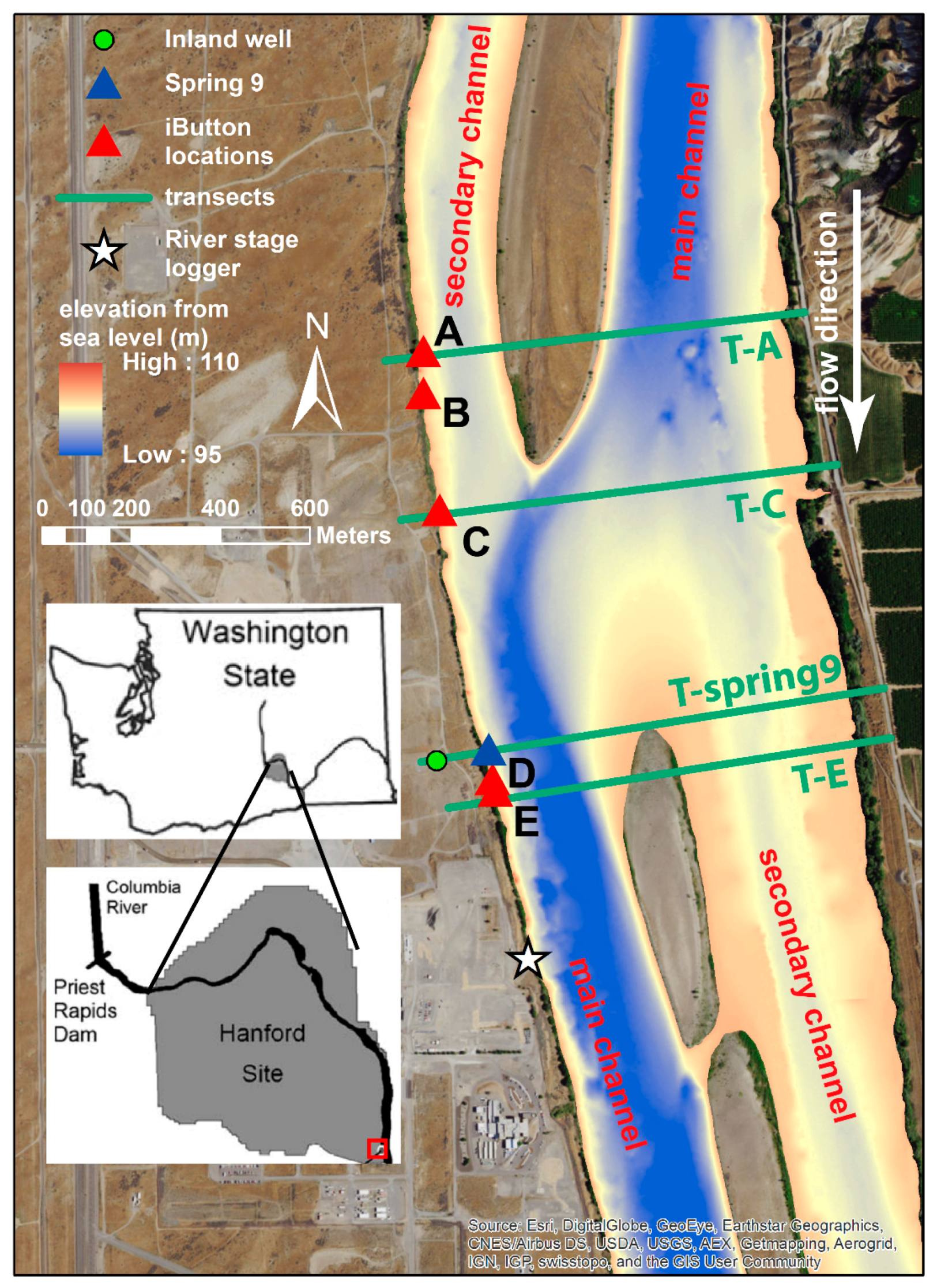


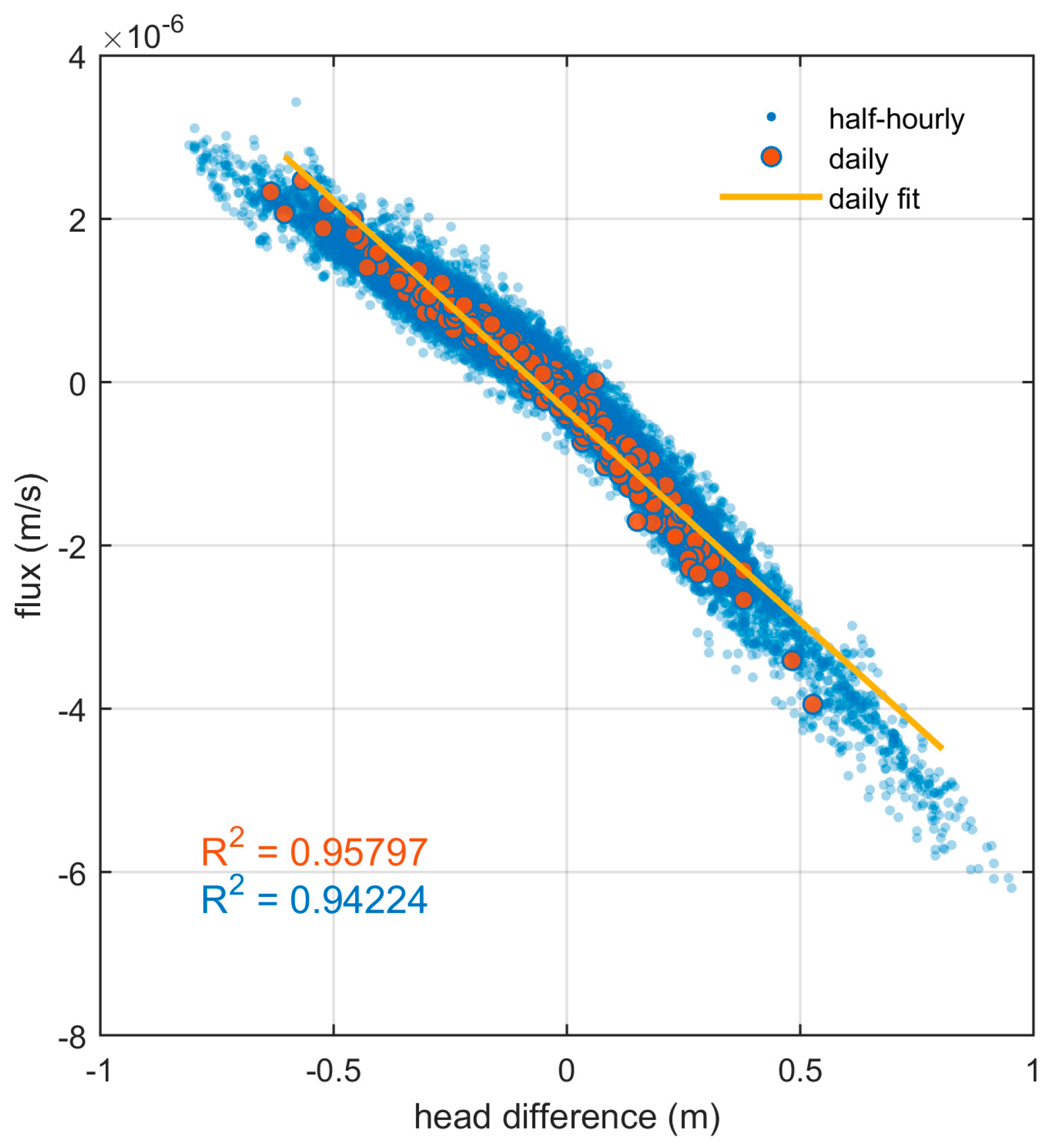

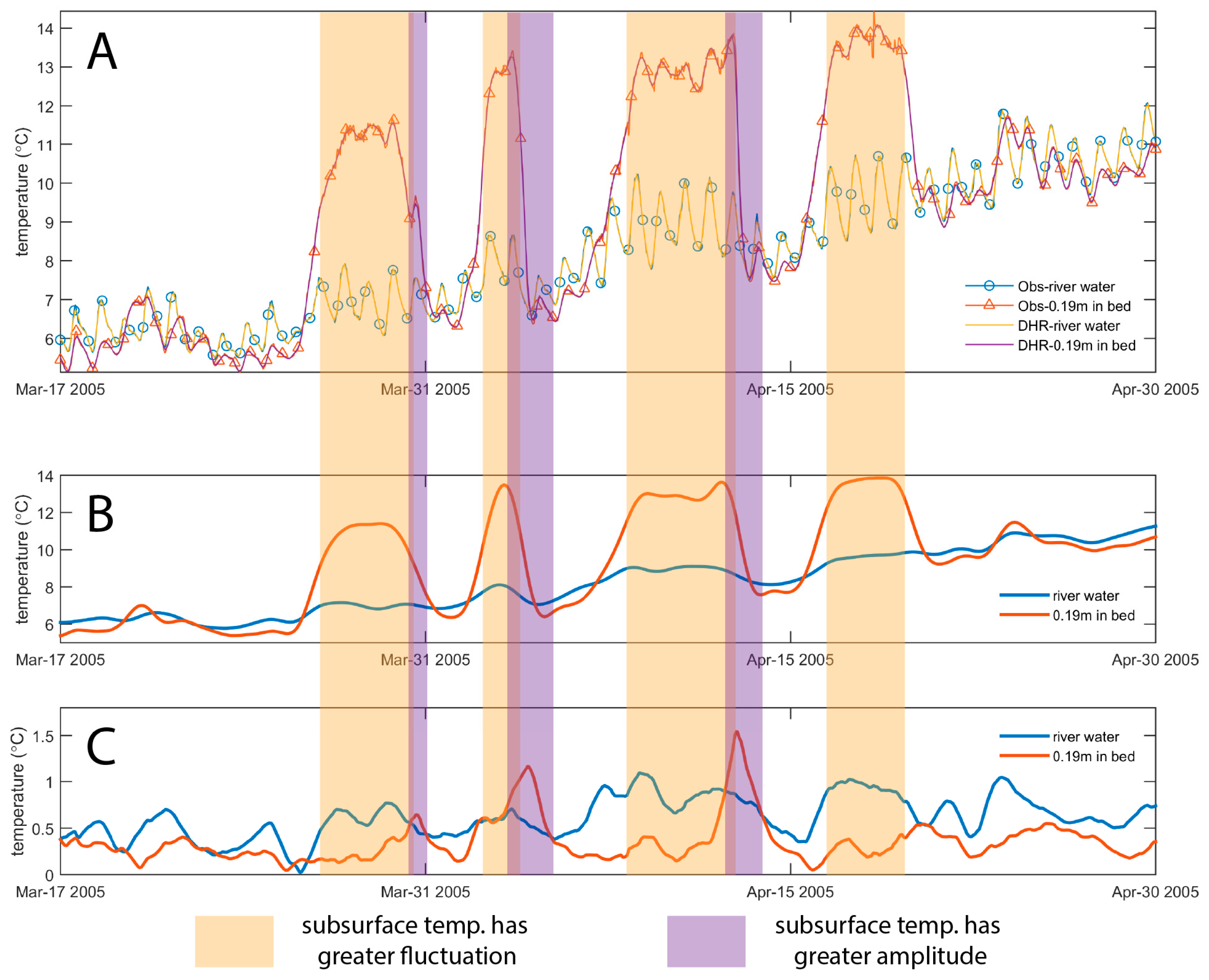
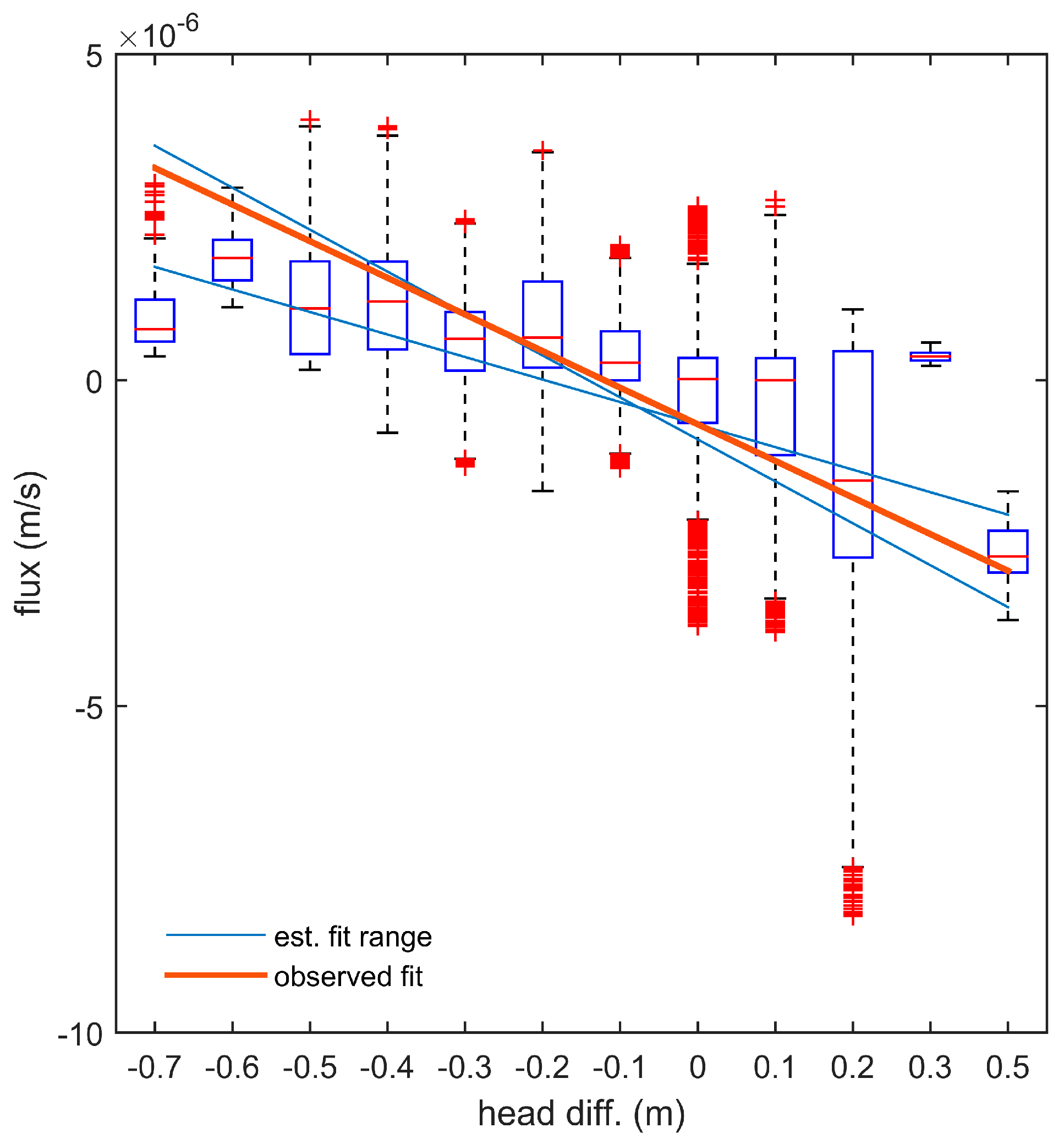
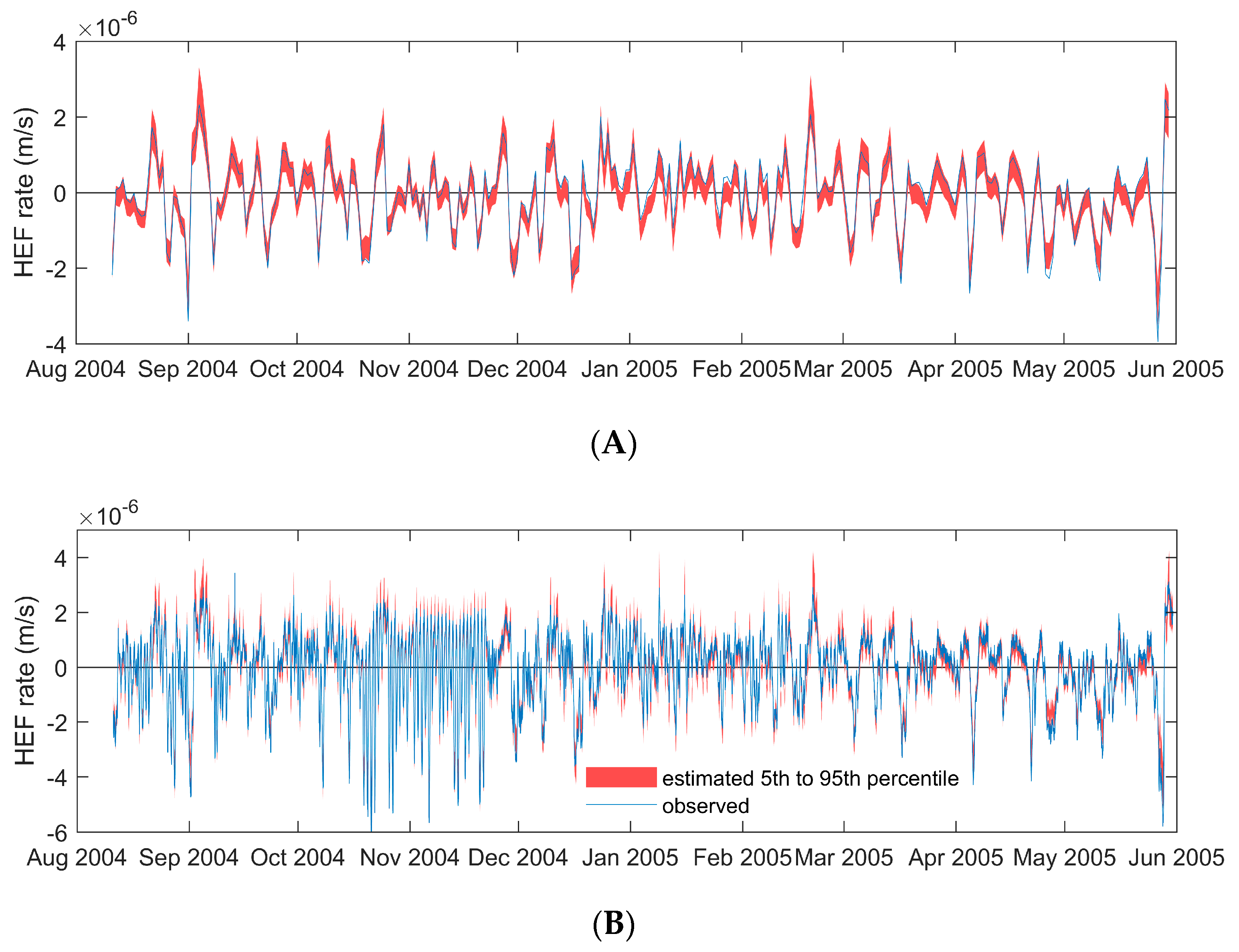
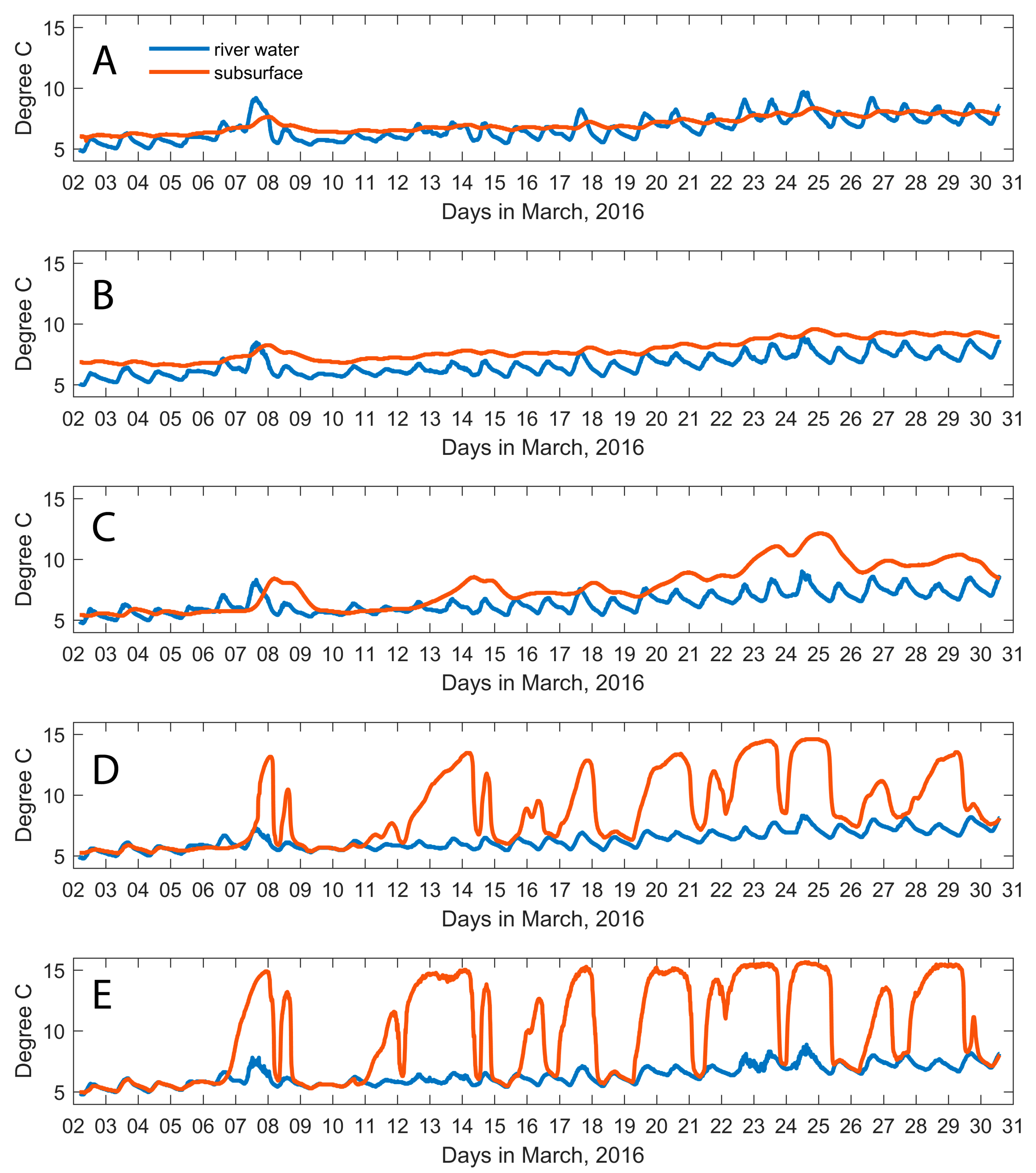

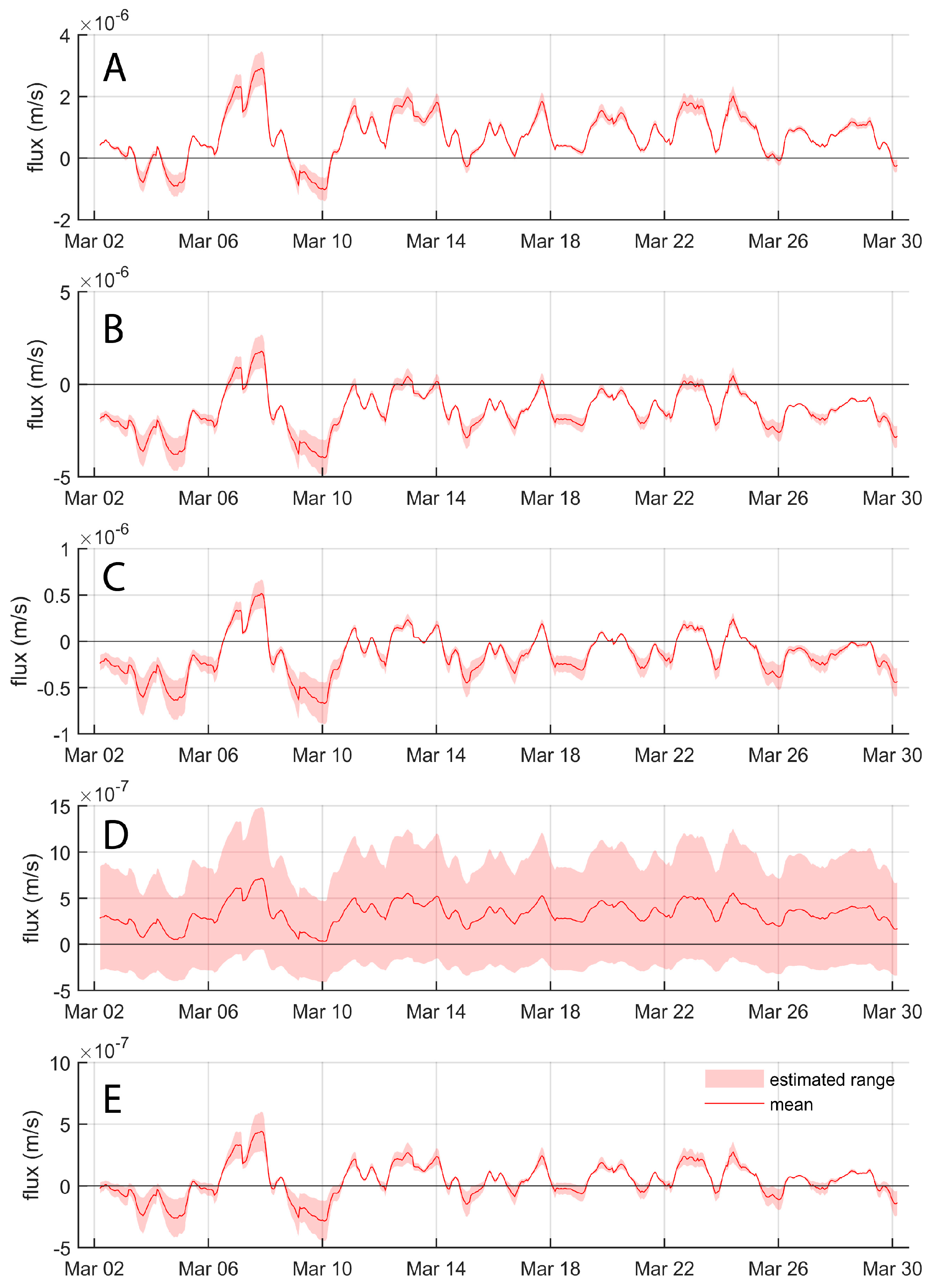
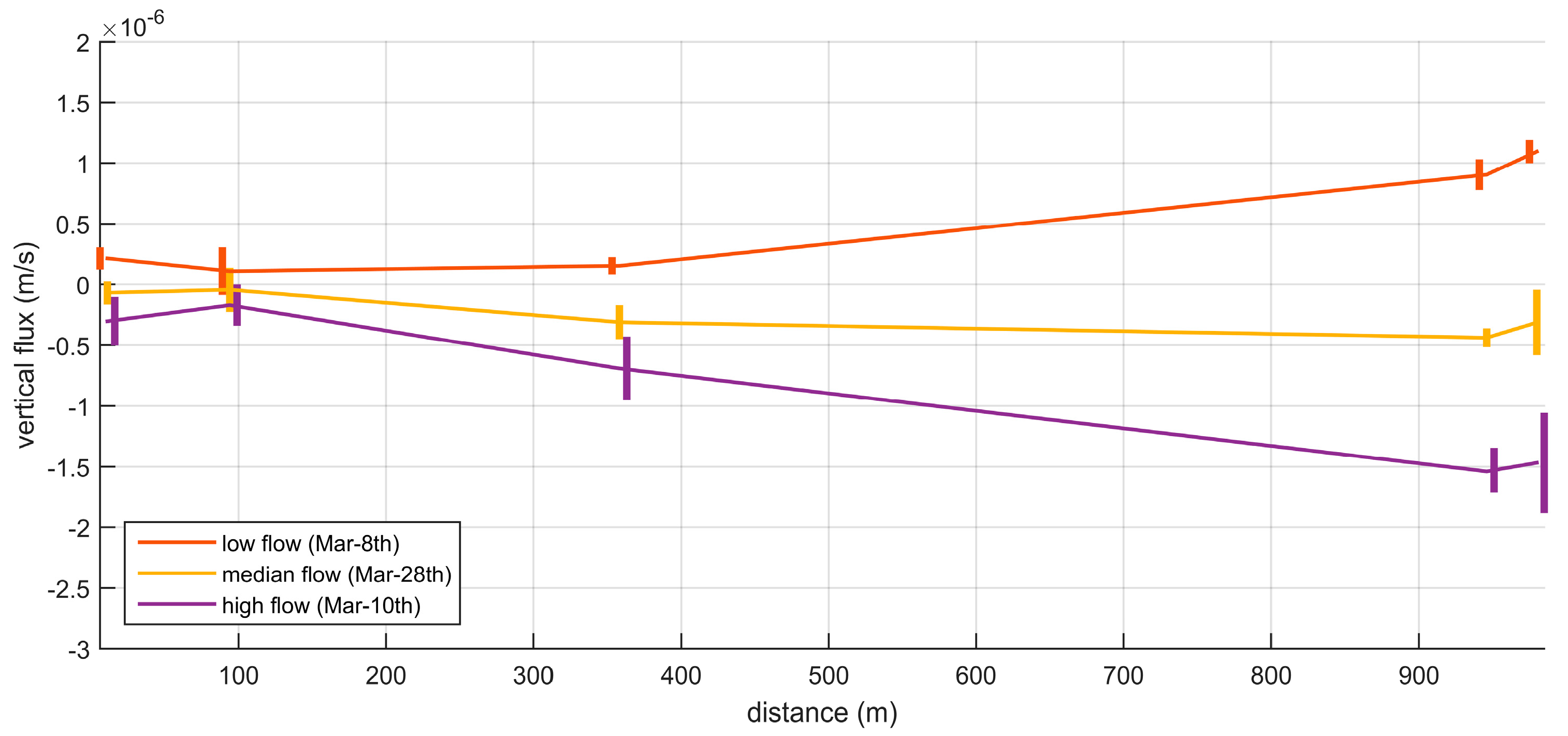
| Parameters | Range (from Ma et al. 2012) |
|---|---|
| Porosity | 0.15~0.18 |
| Solid density (kg/m3) | 2650~2760 |
| Fluid-specific heat capacity (J/(kg K)) | 4186 |
| Soild-specific heat capacity (J/(kg K)) | 715~920 |
| Solid thermal conductivity (W/(m K)) | 1.2~2.2 |
| Fluid thermal conductivity (W/(m K)) | 0.58 |
| Thermal diffusivity (m2/s) | 5.19 × 10−7~2.24 × 10−6 |
| Site | Northing (m) | Easting (m) | Surface Water Sensor (Dist. from River Bed) | Subsurface Sensor (Dist. from River Bed) |
|---|---|---|---|---|
| A | 117,140.6 | 594,347.3 | 25 cm | 25 cm |
| B | 117,046.4 | 594,347.3 | 31 cm | 19 cm |
| C | 116,784.4 | 594,383.5 | 24 cm | 26 cm |
| D | 116,179.5 | 594,502.3 | 22 cm | 28 cm |
| E | 116,153 | 594,509.2 | 37 cm | 13 cm |
© 2017 by the authors. Licensee MDPI, Basel, Switzerland. This article is an open access article distributed under the terms and conditions of the Creative Commons Attribution (CC BY) license (http://creativecommons.org/licenses/by/4.0/).
Share and Cite
Zhou, T.; Huang, M.; Bao, J.; Hou, Z.; Arntzen, E.; Mackley, R.; Crump, A.; Goldman, A.E.; Song, X.; Xu, Y.; et al. A New Approach to Quantify Shallow Water Hydrologic Exchanges in a Large Regulated River Reach. Water 2017, 9, 703. https://doi.org/10.3390/w9090703
Zhou T, Huang M, Bao J, Hou Z, Arntzen E, Mackley R, Crump A, Goldman AE, Song X, Xu Y, et al. A New Approach to Quantify Shallow Water Hydrologic Exchanges in a Large Regulated River Reach. Water. 2017; 9(9):703. https://doi.org/10.3390/w9090703
Chicago/Turabian StyleZhou, Tian, Maoyi Huang, Jie Bao, Zhangshuan Hou, Evan Arntzen, Robert Mackley, Alex Crump, Amy E. Goldman, Xuehang Song, Yi Xu, and et al. 2017. "A New Approach to Quantify Shallow Water Hydrologic Exchanges in a Large Regulated River Reach" Water 9, no. 9: 703. https://doi.org/10.3390/w9090703
APA StyleZhou, T., Huang, M., Bao, J., Hou, Z., Arntzen, E., Mackley, R., Crump, A., Goldman, A. E., Song, X., Xu, Y., & Zachara, J. (2017). A New Approach to Quantify Shallow Water Hydrologic Exchanges in a Large Regulated River Reach. Water, 9(9), 703. https://doi.org/10.3390/w9090703








